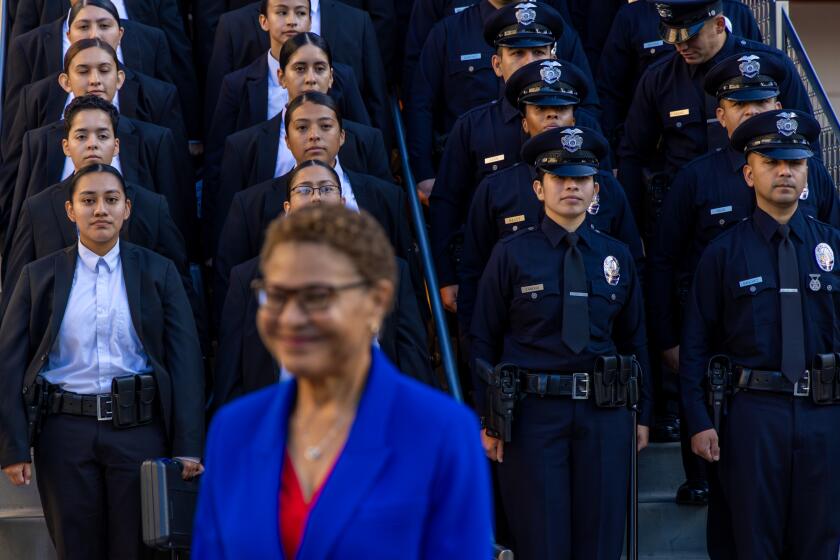Plane’s ‘Strafing Run’ Described by Witnesses
- Share via
A low-flying small plane that crashed off Newport Beach late Sunday appeared to be “on a strafing run” when its right wing clipped the water and sent the aircraft cartwheeling into the sea, a federal investigator said Tuesday.
Donald Llorente, senior investigator for the National Transportation Safety Board, said damage to the main landing gear and the plane’s right front seat--both of which were recovered--indicate that the rented single-engine Piper Archer “hit the water in a right, nose-dive banking turn . . . in excess of 100 m.p.h.”
The four-seater craft then began “cartwheeling to the left,” and the cockpit may have been ripped open upon impact, possibly ejecting all three occupants, Llorente said Tuesday.
Llorente said witnesses told him that the plane had flown over “several residences at extremely low altitudes” and “gained altitude” to about 175 feet as it passed over the Newport Pier and turned sharply toward the ocean. But Llorente stopped short of saying that student pilot Barry John King, who was believed to have been at the controls, violated federal altitude minimums.
“That would be speculation at this point,” he said.
Witnesses also reported that the engine “was running steadily, smoothly,” Llorente said, and there is, as yet, no indication that mechanical problems were a factor in the crash, which occurred at 11:15 p.m. Sunday.
Meanwhile, a salvage crew dragging the ocean floor about one-third of a mile southeast of the Newport Pier failed Tuesday to find any sign of the flight instructor and two student pilots, or additional wreckage.
The search will resume at daybreak today, said Russell Klein, executive director for Vessel Assist, a Costa Mesa-based boater assistance organization that was coordinating the salvage operation with Champion Air Salvage of Oceanside.
Missing and presumed dead are flight instructor Phillip Burdette Peffley, 20, of Irvine; King, 32, of Newport Beach, and Benigno C. Villa, 38, of Costa Mesa.
Peffley was a flight instructor for Aero Flight Center, a school and plane rental company based at John Wayne Airport. Aero Flight officials declined to say how long he had worked for the 15-year-old firm or to answer additional questions.
Acquaintance Invited
Llorente said King hired Peffley to fly Sunday evening, and Villa, an acquaintance of King, was invited to go along. King’s wife told Llorente that her husband had had previous night-flying experience, which is required to qualify for a private pilot’s license.
But King’s flight book, found amid the debris Monday, indicated it had been “a while back,” Llorente said. “Most likely, he (King) had gone up to get rechecked.”
Also found during Monday’s search of waters off Newport Beach were the right wheel from the plane’s main landing gear, the nose landing gear, the right front seat and the left rear seat, he said.
Based upon visual inspection of the recovered plane parts, Llorente said, damage to the right main landing wheel indicates that the “aircraft hit the water in a right, nose-dive banking turn.”
‘Started Cartwheeling’
At the same time, he said, the right front seat “showed extensive downward crushing on the left side . . . That means that when they hit the water, (it) started cartwheeling to the left. . . .
“I have not run (tests) on the metal yet, but the aircraft would have to have been traveling in excess of 100 m.p.h.,” he said.
While 100 m.p.h. is considered a normal, or slightly below normal, cruising speed for a Piper Archer, the plane’s altitude may have been well below the Federal Aviation Administration’s required minimums of 500 feet over the ocean and 1,000 feet over heavily populated areas.
Llorente said many eyewitnesses told him the aircraft flew over “several residences at extremely low altitudes” prior to the crash.
Asked how high the plane may have been flying, Llorente said, “I can tell you that witnesses I interviewed indicated that the plane was proceeding southeast toward the pier. As it approached, it gained in altitude to about 170 to 175 feet, then descended in what they called ‘a sweeping right turn.’
‘Sweeping Turn’
“As the aircraft made this sweeping turn, the right wing made contact with the water and the plane crashed,” he said.
Llorente said several eyewitnesses used the same phrase--”on a strafing run”--to describe the plane’s maneuver.
It is “always possible” that poor visibility was a contributing factor in the crash, Llorente said, but he added that weather conditions reported at 10:45 p.m. Sunday indicated visibility in excess of seven miles with a broken cloud cover at 2,800 feet. Still, he said, two of the witnesses reported that the “clouds seemed to blend with the water.”
Llorente said Aero Flight Center’s flight maintenance records on the Piper Archer were “extremely well documented” and showed that all mechanical work was up to date.
Review Slated
Cause of the crash will be determined by an safety board panel in Washington, but not until it has reviewed a full report of his investigation, probably not for at least several months, he said.
The salvage vessel, the Cobra, searched in depths of 165 to 180 feet of water in an area where an oil slick was found Monday but found nothing from the crash, Klein said. While searchers have been hampered by poor visibility due to low-lying fog, he said the waters have remained relatively calm.
Klein said the insurance carrier for Aero Flight authorized at least another day of searching with drag lines and sonar equipment.
More to Read
Sign up for Essential California
The most important California stories and recommendations in your inbox every morning.
You may occasionally receive promotional content from the Los Angeles Times.










